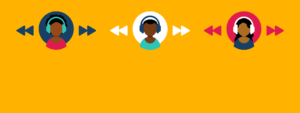Every content provider knows how fundamentally critical it is to understand your audience.
This is beyond true for podcasts. With hundreds of thousands of active podcasts to choose from, success depends on how to get your podcast audience and your advertisers to choose your podcast.
The benefits are clear. The more you know about your current audience, the better positioned you are to keep your content on track at meeting listener expectations. The more information you have on who’s listening to your podcast, the more value you can derive from advertisers looking to find an audience just like yours.
Likewise, it pays to know about the audience you may not have now but would like to have, to inform your marketing and content development.
All of this means you need solid audience intelligence. Yet, it’s often a missing ingredient in podcasting.
Four Ways You Can Gain Valuable Podcast Audience Intelligence for (Almost) Free
There’s a lot you can learn about the audience or prospective audience of just about any size podcast or network, if you’re willing to put in the effort (and maybe a little swag).
1. A Listener Survey
A listener survey is a great place to start. It can deliver serious value for relatively little heavy lifting. All it takes is a brief online survey, a token incentive, and a call-to-action on the podcast inviting listeners to “tell us more about you and what you’d like to hear” on the podcast. (Our Chief Insights Officer, Paul Riismandel ran hundreds of these when he led podcast insights at Stitcher, Midroll and SXM Media.)
You can get a demographic profile of your most engaged listeners – first-party data you can share with advertisers. Perhaps even more important, because they’re fans, these listeners can give you thoughtful and rich verbatim responses in their own words on what they love about your podcast and what they would like you to do to make it better.
2. Open a Dialogue with Your Current Podcast Audience
On a more informal basis, you can interact with your listeners on social media, soliciting their input on things like future topics or guests. Or take that one step further and initiate some one-on-one chats with listeners, probing to understand more about where, how, and why they listen. If you’re not sure what questions to ask, check out this must-read article Tom Webster of Sounds Profitable wrote a few months ago. Tom shared five key questions that will give you deeper insights on both your podcast and your podcast audience.
3. Talk to People You’d Like to Have as Listeners
The downside of #1 and #2 is that you don’t get the perspective of listeners who don’t currently listen to your podcast. Maybe you want to broaden your audience and find out more about content possibilities you wouldn’t get from your faithful core audience. Or perhaps you’re building a whole new show.
Look for those places where that potential podcast audience gathers – for example, an online forum or an in-person conference – and mingle. Spend time with your target and understand their pain points and where a podcast would meet their entertainment and/or information needs.
This is the kind of foundation that Brent Simoneaux and the Red Hat content team laid prior to launching Command Line Heroes, the successful branded podcast they produce with the help of Pacific Content. A researcher himself, Brent plotted a path to get inside the heads of the developers who would be the target audience for the podcast, including attendance at a series of customer events. At one of those events, they even set up a booth offering coffee and the services of a caricature artist, all the while probing developers about their content interests. Red Hat continued to interview developers after the launch to refine the podcast and get new ideas for editorial. In total, they’ve done 796 interviews since 2017.
4. Identify Your ‘Neighbor’ Podcasts
Another ready tool you can use to help find new podcast opportunities – and market your podcast – comes by way of the Apple Podcasts API. One of the byproducts of the API is that it allows you to access millions of connections of podcasts that ‘listeners also subscribed to.’
A few years ago, Dan Meisner of Bumper grouped together those podcasts with the most shared connections into ‘neighborhoods.’ Expanding on Dan’s work, the folks at Rephonic provide an interactive 3D graph on their website where you can see the neighborhoods of virtually any podcast. This lets you see those podcasts that are ripe for cross-promotion as well as possible content gaps in your neighborhood.
Closing the Knowledge Gaps for Advertisers…
Each of the above offers valuable opportunities to know your podcast audience when it comes to content. But they don’t on their own give podcast advertisers all of what they need to know about your audience.
Still missing are independent third-party demographics and socio-demographics for individual podcasts. As advertisers are looking to execute increasingly large buys across the full podcast landscape, much of what is available now is a patchwork of first-party data from publishers or podcasts measured at the household level via IP address.
The good news is these gaps are closing.
In the past couple of years, Nielsen Scarborough has launched Podcast Buying Power and Edison Research its Podcast Metrics product, both of which offer third-party demos for the hit podcasts and publishers. Meanwhile, we’ve had the privilege of working with Triton Digital on developing Demos+, which uses data science to combine census level and survey data to provide demographic and socio- demographic estimates for several thousand of the leading podcasts.
What knowledge gaps are you looking to close?
Let us know, as we’ll be exploring the cutting edge of audience data, sharing insights for podcasters. publishers and advertisers next month at Podcast Movement in Denver. Come join Pierre Bouvard of Cumulus Media, Daryl Battaglia of Triton Digital and me for Who’s Listening to your Podcast? Grow your Audience with Enhanced Analytics, Wednesday, August 23 at 11:15am.




